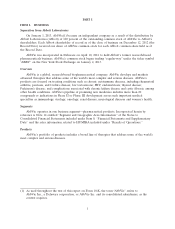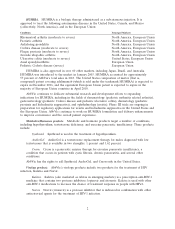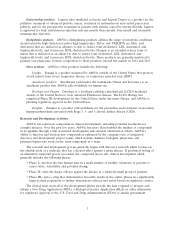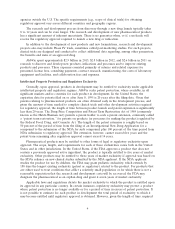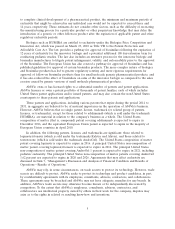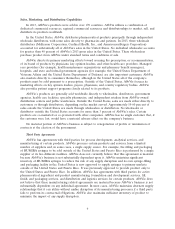AbbVie 2013 Annual Report Download - page 15
Download and view the complete annual report
Please find page 15 of the 2013 AbbVie annual report below. You can navigate through the pages in the report by either clicking on the pages listed below, or by using the keyword search tool below to find specific information within the annual report.(DRG) payment system for certain institutional services provided under Medicare or Medicaid and has
implemented a prospective payment system (PPS) for services delivered in hospital outpatient, nursing
home, and home health settings. DRG and PPS entitle a health care facility to a fixed reimbursement
based on the diagnosis and/or procedure rather than actual costs incurred in patient treatment, thereby
increasing the incentive for the facility to limit or control expenditures for many health care products.
Medicare reimburses Part B drugs based on average sales price (ASP) plus a certain percentage to
account for physician administration costs, which have recently been reduced in the hospital outpatient
setting. End stage renal disease treatment is covered through a bundled payment that likewise creates
incentives for providers to demand lower pharmaceutical prices. Medicare enters into contracts with
private plans to negotiate prices for most patient-administered medicine delivered under Part D.
In March 2010, Congress enacted the Patient Protection and Affordable Care Act and the Health
Care and Education Reconciliation Act (together, the Affordable Care Act). Under the Affordable
Care Act, AbbVie pays a fee related to its pharmaceuticals sales to government programs. Also in 2011,
AbbVie began providing a discount of 50 percent for branded prescription drugs sold to patients who
fall into the Medicare Part D coverage gap, or ‘‘donut hole.’’
The Affordable Care Act also includes provisions known as the Physician Payments Sunshine Act,
which require manufacturers of drugs and biologics covered under Medicare and Medicaid starting in
2012 to record any transfers of value to physicians and teaching hospitals and to report this data
beginning in 2013 to the Centers for Medicare and Medicaid Services for subsequent public disclosure.
Similar reporting requirements have also been enacted on the state level in the United States, and an
increasing number of countries worldwide either have adopted or are considering similar laws requiring
disclosure of interactions with health care professionals. Failure to report appropriate data may result
in civil or criminal fines and/or penalties.
AbbVie expects debate to continue during 2014 at all government levels worldwide over the
marketing, availability, method of delivery, and payment for health care products and services. AbbVie
believes that future legislation and regulation in the markets it serves could affect access to health care
products and services, increase rebates, reduce prices or the rate of price increases for health care
products and services, change health care delivery systems, create new fees and obligations for the
pharmaceuticals industry, or require additional reporting and disclosure. It is not possible to predict the
extent to which AbbVie or the health care industry in general might be affected by the matters
discussed above.
AbbVie is subject to a Corporate Integrity Agreement (CIA) entered into by Abbott on May 7,
2012 that requires enhancements to AbbVie’s compliance program and contains reporting obligations,
including disclosure of financial payments to doctors. If AbbVie fails to comply with the CIA, the
Office of Inspector General for the United States Department of Health and Human Services may
impose monetary penalties or exclude AbbVie from federal health care programs, including Medicare
and Medicaid.
European Union. The European Union has adopted directives and other legislation governing
labeling, advertising, distribution, supply, pharmacovigilance, and marketing of pharmaceutical products.
Such legislation provides mandatory standards throughout the European Union and permits member
states to supplement these standards with additional regulations. European governments also regulate
pharmaceutical product prices through their control of national health care systems that fund a large
part of the cost of such products to consumers. As a result, patients are unlikely to use a
pharmaceutical product that is not reimbursed by the government. In many European countries, the
government either regulates the pricing of a new product at launch or subsequent to launch through
direct price controls or reference pricing. In recent years, many countries have also imposed new or
additional cost containment measures on pharmaceutical products. Differences between national pricing
regimes create price differentials within the European Union that can lead to significant parallel trade
in pharmaceutical products.
11


